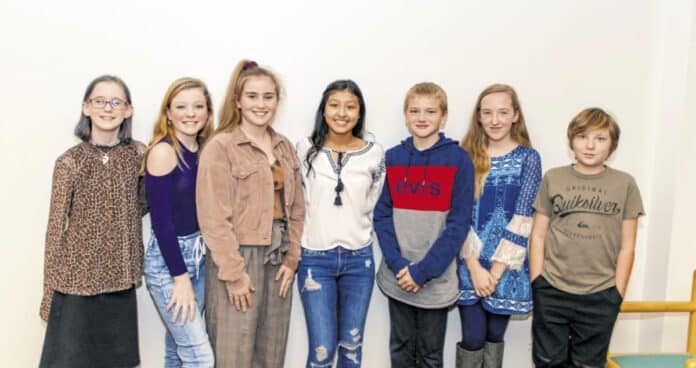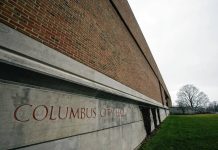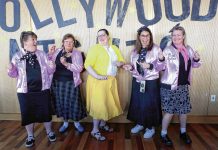
When Gage Riley walks to his Lafayette Avenue home from Central Middle School, he must navigate the uneven, cracked sidewalks that have crumbled from several years of wear and tear.
McKenna Schnepp and her family ride their bikes through the alleyway between SIHO Insurance Services and Henry Social Club in downtown Columbus all the time, but without any lights to keep the dark corridor bright, she said they’re hesitant to travel through the alley at night.
What makes Riley and Schnepp unique? To start, they’re in seventh grade. But through a collaboration with five other Central Middle School students, they are proving that age is only a number when it comes to enacting change in their local community.
Seventh graders at Central Middle School were challenged earlier this year to find an issue in the community and create a solution. In groups of three to four, students brainstormed ideas for issues they or their neighbors may face in Columbus. Once they decided which issue they would tackle, the groups completed hours of research to create a sustainable solution that could benefit several people across the community.
[sc:text-divider text-divider-title=”Story continues below gallery” ]
Each group presented their projects to a panel of teachers and a representative of the Columbus Planning Department. Two groups would be selected to present their projects to Columbus City Council at a public meeting.
Sidewalk safety
The first group, made up of Riley, Ethan Hall, Graecen Scott and Savannah Shreve spent several hours brainstorming an issue to tackle. Riley told his peers about the poor sidewalks he and many other classmates navigate every afternoon to get home.
Every day, Riley watches kids try to ride their bikes and mothers attempt to push strollers down the sidewalk, currently being overtaken by tree roots and cracks in every direction.
They started calculating costs using square footage and determined that for 16 blocks of sidewalk priced at about $4 per square foot with the additional two feet, the project would cost them roughly $110,808.
The group presented to City Council its idea to replace the sidewalk and add two feet to the sidewalk’s width, making it more accessible for pedestrians.
“The sidewalks on Lafayette Avenue are crumbling and are not in great condition,” Hall told City Council members on Nov. 6. “Many students from Central live on Lafayette Avenue and most of them ride their bikes to school. We don’t want them to ride over a bump, hurt themselves and miss school.”
They also proposed the city add two feet to the current three-feet-wide sidewalks to match the minimum width of a bike lane, Hall said.
Councilman Tim Shuffett said the city’s standard sidewalk width is typically five feet, and he encouraged the council to take the three-feet-wide sidewalks into consideration.
“You guys did your homework,” Shuffett said. “Great job.”
Lighting up Columbus
Schnepp and her partners Sierra Battin and Jossalin Resendiz sought a solution for one of Columbus’ dark alleyways. How could they brighten up the alleyway frequently-used alleyway between Henry Social Club and SIHO Insurance Services while also saving energy, they asked themselves.
“We looked at a couple different ideas, like lighting and fully decorating the alleyways,” Battin said. “Our original idea was to have benches, plants and seating areas, but we realized a lot of the downtown alleyways are open to traffic. So we had to choose an alleyway that we could improve.”
Resendiz said their group discovered a study completed by Chicago University that showed that streets with no lighting had a significant increase of crime, and that by adding lighting, the crime index is reduced by 36%.
“We want to add decoration as well as lighting so this place will feel more comfortable as well as welcoming for the citizens of Columbus, and we also want to incorporate some of the architecture surrounding these alleyways so it will also be an attraction for tourists,” Schnepp said. “Our main focus for this project is the make sure the citizens of Columbus feel comfortable while doing their activities at night.”
The group divided its project into three steps. First, they would collaborate with the local business owners to receive permission to add lighting to the buildings and get input on the lighting designs.
Second, they said they would apply for a grant or city funding to pay for the project. Finally, they would draw up a final plan and have the lighting fixtures installed. Battin said cars would still be able to travel through the alleyway if necessary because the lighting would be high enough off the ground.
“Another thing you’re going to have to consider, which I love the idea, is there are people who live in the apartments above some of these buildings, so if you do end up putting lighting there, you’ll have to get sign-off by those homeowners, too, because then they’ll have lights coming through their windows,” said councilwoman Elaine Wagner.
Councilman Tom Dell told the girls they were creating a great design of safety and attraction that makes the city more walkable.
“When it’s lit and safe at night, which you pointed out extremely well, it just enhances the impact of what that actually does,” Dell said.
The reflection piece
Resendiz said she doesn’t think the groups’ projects would have been possible if it weren’t for the project-based learning approach at Central Middle School, which is a part of BCSC’s Columbus Signature Academy program.
“I went to (CSA) Lincoln Elementary, and we did projects like that within the community because I think that’s part of CSA,” Battin said. “I’ve never really done a project that actually could have an effect. We do the projects but this one was a bigger deal because if we were to get chosen, we actually have a shot at changing something in the community that we can put our name on.”
Riley, who said he is new to the project-based learning approach, said this project was one of his first. He said by completing projects like this one, it helps students in the future with their research and presentation skills.
Schnepp said she would like to prepare better in the future for the type of audience they’ll present to. She said the group went into it thinking they would be presenting to a large room of people, but instead, it just felt like they were talking to their teachers.
“I think it’s crazy that we’re seventh graders and got to potentially help lots of people through our ideas when there are a bunch of adults doing the exact same thing,” Schnepp said.




